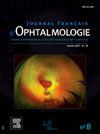上眼睑成形术前降温有效吗?一项对照、随机、观察者盲法研究。
IF 1.1
4区 医学
Q3 OPHTHALMOLOGY
引用次数: 0
摘要
目的:探讨上睑成形术前眼睑降温对疼痛、水肿、红斑、血肿的影响,并首次在文献中报道。方法:选取42例拟行上睑成形术的患者为研究对象。选择一只眼睑(右眼)进行冷却,另一只眼睑在手术前不进行冷却。患者使用视觉模拟评分(0 - 10)报告疼痛评分,并由同一眼科医生在术后1小时、1天和1周拍摄照片。根据这些照片使用相应的分级量表对眼睑瘀斑和水肿进行评估和分类。结果:与未冷却眼睑相比,冷却眼睑术后第1天水肿明显减少(P0.05)。术后1小时和1天,冷却后的眼睑疼痛明显减轻(结论:我们建议在眼睑成形术之前而不是之后使用冷却,因为它可以减轻疼痛和水肿,并降低患者的依从性。本文章由计算机程序翻译,如有差异,请以英文原文为准。
Is cooling effective before upper lid blepharoplasty? A controlled, randomized, observer-blinded study
Purpose
To determine the efficacy of eyelid cooling before upper lid blepharoplasty in terms of pain, edema, erythema, and hematoma and report the results for the first time in the literature.
Methods
Forty-two patients who were scheduled to undergo upper lid blepharoplasty were enrolled in this study. One eyelid (right eye) was chosen to be cooled, and the other eyelid was left uncooled before the surgery. Pain scores were reported by the patients using a Visual Analog Scale (0 to 10), and photographs were obtained by the same ophthalmologist 1 hour, 1 day, and 1 week after surgery. The ecchymosis and edema of the eyelids were evaluated and classified according to these photographs using respective graded scales.
Results
Compared with the uncooled lids, less edema was observed on postoperative day 1 in the eyelids treated by cooling (P < 0.01). The degree of eyelid ecchymosis did not differ between the two groups (P > 0.05). Pain in the cooled eyelids was significantly less 1 hour and 1 day after surgery (P < 0.01), but did not differ 1 week after surgery.
Conclusions
We recommend the use of cooling before, not after, blepharoplasty, as it reduces pain and edema and eliminates patient compliance.
Objectif
Déterminer l’efficacité du refroidissement des paupières avant une blépharoplastie de la paupière supérieure sur la douleur, l’œdème, l’érythème et l’hématome, et rapporter ces résultats pour la première fois dans la littérature.
Méthodes
Quarante-deux patients programmés pour une blépharoplastie des paupières supérieure ont été inclus dans cette étude. Une paupière (l’œil droit) a été choisie pour un refroidissement tandis que l’autre paupière n’a pas été refroidie avant la chirurgie. Les scores de douleur ont été mesurés par les patients à l’aide d’une échelle visuelle analogique (0 à 10) et des photographies ont été obtenues par le même ophtalmologiste 1 heure, 1 jour et 1 semaine après l’intervention chirurgicale. Les ecchymoses et les œdèmes des paupières ont été évalués et classés selon ces photographies en utilisant des échelles graduées respectives.
Résultats
Comparés aux paupières non refroidies, un œdème moindre a été observé sur les paupières traitées par refroidissement au premier jour postopératoire (p < 0,01). Le degré d’ecchymoses des paupières ne différait pas entre les deux groupes (p > 0,05). La douleur dans les paupières refroidies était significativement moins importante 1 heure et 1 jour après la chirurgie (p < 0,01) mais ne différait pas 1 semaine après la chirurgie.
Conclusions
Nous recommandons l’utilisation du refroidissement avant la blépharoplastie et non après, car cela réduit la douleur et l’œdème, tout en améliorant l’adhésion du patient.
求助全文
通过发布文献求助,成功后即可免费获取论文全文。
去求助
来源期刊
CiteScore
1.10
自引率
8.30%
发文量
317
审稿时长
49 days
期刊介绍:
The Journal français d''ophtalmologie, official publication of the French Society of Ophthalmology, serves the French Speaking Community by publishing excellent research articles, communications of the French Society of Ophthalmology, in-depth reviews, position papers, letters received by the editor and a rich image bank in each issue. The scientific quality is guaranteed through unbiased peer-review, and the journal is member of the Committee of Publication Ethics (COPE). The editors strongly discourage editorial misconduct and in particular if duplicative text from published sources is identified without proper citation, the submission will not be considered for peer review and returned to the authors or immediately rejected.

 求助内容:
求助内容: 应助结果提醒方式:
应助结果提醒方式:


